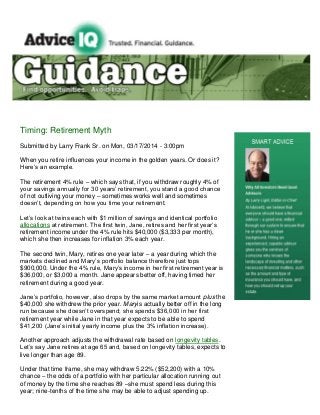
Timing retirement myth advice iq
- 1. Timing: Retirement Myth Submitted by Larry Frank Sr. on Mon, 03/17/2014 - 3:00pm When you retire influences your income in the golden years. Or does it? Here’s an example. The retirement 4% rule – which says that, if you withdraw roughly 4% of your savings annually for 30 years’ retirement, you stand a good chance of not outliving your money – sometimes works well and sometimes doesn’t, depending on how you time your retirement. Let’s look at twins each with $1 million of savings and identical portfolio allocations at retirement. The first twin, Jane, retires and her first year’s retirement income under the 4% rule hits $40,000 ($3,333 per month), which she then increases for inflation 3% each year. The second twin, Mary, retires one year later – a year during which the markets declined and Mary’s portfolio balance therefore just tops $900,000. Under the 4% rule, Mary’s income in her first retirement year is $36,000, or $3,000 a month. Jane appears better off, having timed her retirement during a good year. Jane’s portfolio, however, also drops by the same market amount plus the $40,000 she withdrew the prior year. Maryis actually better off in the long run because she doesn’t overspend; she spends $36,000 in her first retirement year while Jane in that year expects to be able to spend $41,200 (Jane’s initial yearly income plus the 3% inflation increase). Another approach adjusts the withdrawal rate based on longevity tables. Let’s say Jane retires at age 65 and, based on longevity tables, expects to live longer than age 89. Under that time frame, she may withdraw 5.22% ($52,200) with a 10% chance – the odds of a portfolio with her particular allocation running out of money by the time she reaches 89 –she must spend less during this year; nine-tenths of the time she may be able to adjust spending up.
- 2. That 10% is Jane’s possibility of adjustment (POA) in her first year. POA signals how much or little the stress of spending puts on a portfolio through a year and the percentage of simulations in which savings run out before the end of a timespan. The more simulations fail, the clearer the signal to do something. Adjusting spending is most effective; market timing, which means making investment decisions based on your predictions of stocks’ up and downs, is by far the least effective. When Jane’s portfolio value falls to approximately $904,000, she must cut her monthly spending to approximately $3,935 to preserve her portfolio value for future years. She can gamble: Adjusting sooner retains unspent portfolio value but may necessitate adjustments more often if economic or market conditions keep falling; waiting to adjustmay avoid an adjustment if portfolio values stop short of reaching a low point of decision. The hitch: If values do reach that low, the spending adjustment must be larger. Look at the situation a year into Jane’s retirement, as her twin sister Mary retires. They are both 66 and expect to live, now, 23 more years. Though the twins’ portfolio balances both stand at some $904,000, they can withdraw more (5.38%) because less time remains in their expected retirements. Both twins may now prudently start the year spending approximately $4,053 a month (5.38% of $904,000, divided by 12). Jane started retirement with spending expectations based on $1 million – an amount that market slides soon whittled. Mary entered retirement with a lower balance and a spending expectation lower than her sister’s. Both may make small spending adjustments based on their market risk and exposure in the (extremely unknown) future. Higher spending becomes possible if portfolio values rise. Portfolio value exceeding monthly living expenses goes, for example, to replacing Jane’s old car, Mary’s home repairs or both sisters’ money reserves that they spent during the last market swoon. Some advisers use a POA percentage as a figure of constant adjustment in spending during the present year: Spending matches a portfolio value’s rise and fall to keep the POA constant. More practical, because spending doesn’t constantly change, is to use the POA as a reference to adjust spending less often, at key decision points. Frequent looks at failing simulations and reassessment of portfolios and spending are the best measures to evaluate and monitor how to meter out money in retirement. These twins demonstrate that when you retire is a myth of expectations. The markets affect everyone with similar allocations the same. Having expectations to make small adjustments, either up or down, to spending over time helps you retain your portfolio as needed for future income
- 3. needs. An annual review of both portfolio value and longevity tables works to monitor prudent spending. Moral of the story: She who spends more is more likely to run out if money. Up until now, it was hard to tell when too much was spent. Follow AdviceIQ on Twitter at @adviceiq. Larry R. Frank Sr., CFP, is a Registered Investment Adviser (California) in Roseville, Calif. He is the author of the book, Wealth Odyssey. He has an MBA with a finance concentration and B.S. cum laude in physics with which he views the world of money dynamically. He has peer-reviewed research published in the Journal of Financial Planning. http://blog.betterfinancialeducation.com/. AdviceIQ delivers quality personal finance articles by both financial advisors and AdviceIQ editors. It ranks advisors in your area by specialty, including small businesses, doctors and clients of modest means, for example. Those with the biggest number of clients in a given specialty rank the highest. AdviceIQ also vets ranked advisors so only those with pristine regulatory histories can participate. AdviceIQ was launched Jan. 9, 2012, by veteran Wall Street executives, editors and technologists. Right now, investors may see many advisor rankings, although in some areas only a few are ranked. Check back often as thousands of advisors are undergoing AdviceIQ screening. New advisors appear in rankings daily. Topic: Retirement Planning Asset Allocation Spending
